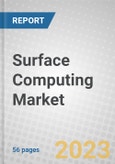The report provides an overview of the global surface computing market and a detailed analysis of the market players’ products and strategies. Using 2022 as the base year, the report provides estimated market data for 2023 through 2028. Revenue forecasts for this period are segmented based on vision, type, industry, and geography.
The report also focuses on the significant drivers and challenges that affect the market and the vendor landscape. The report explains the current trends in the global surface computing market and concludes with detailed profiles of the major players.
Report Includes
- An up-to-date overview and analysis of the current and future global markets for surface computing
- Analyses of the global market trends, with historical market revenue data (sales figures) for 2022, estimates for 2023, forecasts for 2024, and projections of compound annual growth rates (CAGRs) through 2028
- Estimation of the actual market size and revenue forecast for global surface computing market, and corresponding market share analysis based on vision, type, end-use industry, and region
- In-depth information (facts and figures) concerning the market growth drivers, opportunities and challenges, prospects, technologies, regulatory scenarios, and the impact of COVID-19 and Russia-Ukraine war on surface computing market
- Discussion of ESG developments in surface computing market, with emphasis on importance of ESG, consumer attitudes, risks and opportunity assessment, and ESG followed practices
- Identification of the major stakeholders and analysis of their company competitive landscape based on recent developments, key financials, and operational integration
- Company profiles of the leading market players
Table of Contents
Executive Summary
Surface computing is a revolutionary technology that permits users to interact with digital content and data through direct manipulation of physical objects or surfaces. Surface computing uses touch-sensitive displays, multitouch gestures, and natural user interfaces to provide a more intuitive and immersive user experience than traditional computing interfaces such as the keyboard and mouse. This technology seamlessly integrates the physical and digital realms, allowing users to interact with both simultaneously. As businesses and consumers seek more immersive and intuitive experiences, this market has seen an uptick in adoption across multiple industries, including retail, hospitality, healthcare, and education.
The proliferation of advanced technologies such as gesture recognition, multitouch sensing, and augmented reality has fueled the expansion of surface computing, facilitating natural and seamless interactions with digital content. In response to the growing demand for interactive and engaging solutions, the market for surface computing is anticipated to continue its ascent, spurring innovation and transforming how people interact with the digital world.
The global surface computing market is segmented based on vision, type, industry, and geography. The vision segment has been categorized into two-dimensional and three-dimensional.
Based on type, the surface computing market has been segmented into flat display and curved display.
By geographical region, the surface computing market has been segmented into North America, Europe, Asia-Pacific, and Rest of World (RoW). North America is currently the most dominant region in the global surface computing market. The presence of leading global companies, robust technology infrastructure, and high adoption of advanced technologies such as iPads and tablets are key factors driving the North American market.
Companies Mentioned
- 3M
- Apple Inc.
- Dell Inc.
- Fujitsu Ltd.
- Hewlett Packard Enterprise
- Ibm Corp.
- Intel Corp.
- Lenovo Group Ltd.
- Lg Electronics Inc.
- Microsoft Corp.
- Qualcomm Technologies Inc.
- Samsung Electronics Co. Ltd.
- Sony Corp.
- Toshiba Corp.
- Viewsonic Corp.








